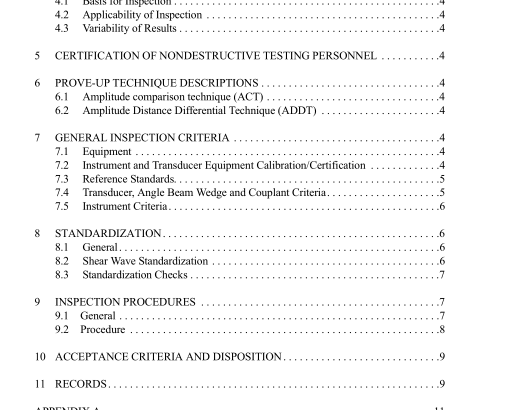API 5UE:2020 pdf free download.Recommended Practice for Ultrasonic Evaluation of Pipe Imperfections
3.38 longitudinal imperfection: An imperfection that has its principal direction or dimension approximately parallel to the longitudinal pipe axis.
3.39 marking: Assorted marks on tubular products, which includes inspection markings made with paint sticks and sten- cils, and ball-point paint tubes.
3.40 nondestructive testing (NDT): Inspection to detect defects or imperfections in materials, using techniques that do not damage or destroy the items being tested.
3.41 notch: See reference indicator.
3.42 oblique imperfection: An imperfection at an angle other than longitudinal or transverse to the axis of the pipe.
3.43 operator: The person present throughout the inspec- tion or testing process who is responsible for the ultrasonic inspection unit, operates the controls, and observes the read- out to detect imperfections.
3.44 owner: The entity who has ownership of the pipe at the time inspection is contracted, specifies and authorizes the type of inspection or testing to be conducted. The owner may be the purchaser.
3.45 parallax: Apparent displacement, or difference in the apparent position, of an object, caused by the actual change of the point of observation.
3.46 peak memory mode: An instrument capability that captures and stores the Ascan display.
3.47 pipe: Includes oil field casing, plainend casing liners, tubing, plain-end drill pipe, line pipe, coiled line pipe, pup joints, coupling stock, and connector material. 3.48 plain-end: Pipe end without threads or tool joint.
3.49 planar: This term refers to an imperfection lying in one geometric plane that is normally parallel to, and within, the outer and inner surfaces.
3.50 prime pipe: Pipe meeting all of the specified inspection and testing requirements.
3.51 prove-up: The ultrasonic processes described within this RP for measuring and evaluating imperfections.
3.52 pulse: A short wave train of mechanical vibrations.
3.53 pulse-echo method: An ultrasonic test method that both generates ultrasonic pulses and receives the return echo.
3.54 quality program: A documented system to ensure quality.
3.55 recommended practice (RP): A standard to facilitate the broad availability of proven sound engineering and operating practices.
3.56 reference indicator: Real or artificial discontinuities in a reference standard that provide reproducible sensitivity levels for inspection equipment. Artificial indicators may be holes, notches, grooves, or slots.
3.57 reference standard: A pipe, or pipe section, containing one or more reference indicators used as a base for comparison or for inspection equipment standardization. 3.58 reflection: The return of sound waves from surfaces.
3.59 sensitivity: The size of the smallest imperfection detectable by a nondestructive test method with an acceptable signal-to-noise level.
3.60 shall: Used to indicate that a provision is mandatory.
3.61 should: Used to indicate that a provision is not mandatory but recommended as good practice.
3.62 signal: An electronic response of NDT equipment to an imperfection or defect.
3.63 signal envelope: The curve that encompasses successive return signals along the time-base on an A-scan display as an imperfection is scanned.
3.64 signal-to-noise ratio: The ratio of the signal from a significant imperfection or defect to signals generated from surface noise.
3.65 6 dB drop technique: An ultrasonic technique tra- ditionally used as a means for the dimensional sizing of lami- nar imperfections in plate and for measuring the length of radial imperfections.
3.66 skip distance: In angle beam examination, the dis- tance along the test surface, from sound entry point to the point at which the sound returns to the same surface. It can be considered the top surface distance of a complete vee path of sound in the test material. 3.67 skip position: The location on the A-scan display, along the time-base, relative to the skip distance for a given reflector.
3.68 sound path distance: The distance ultrasound travels from the entry point in the material to a given reflector.API 5UE pdf download.API 5UE:2020 pdf free download
